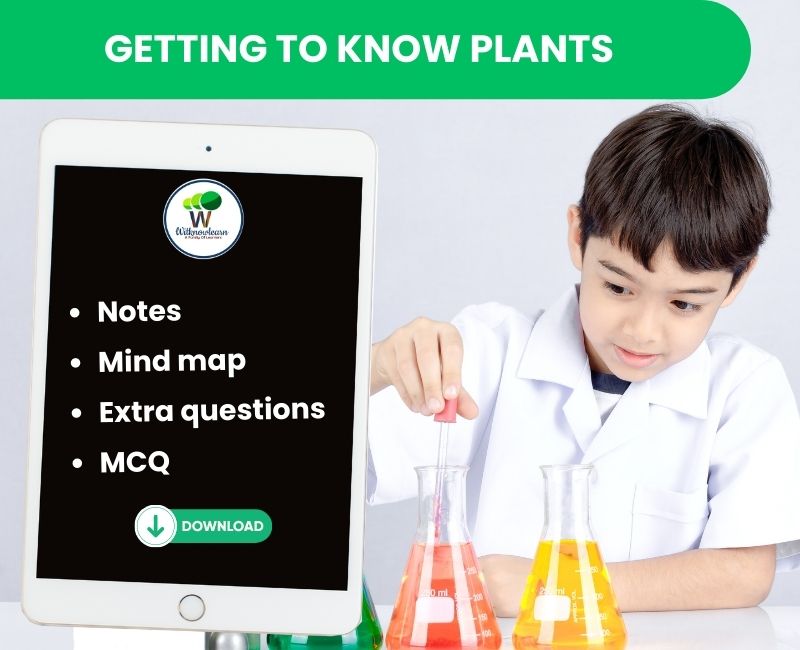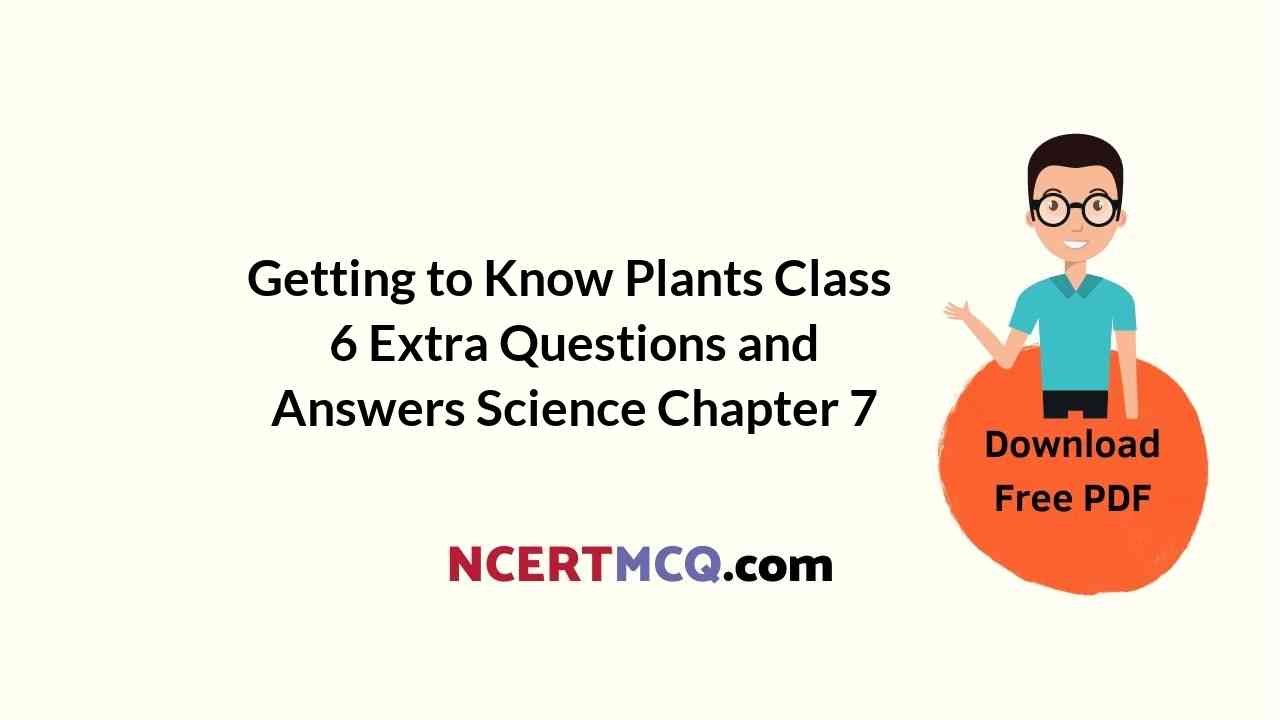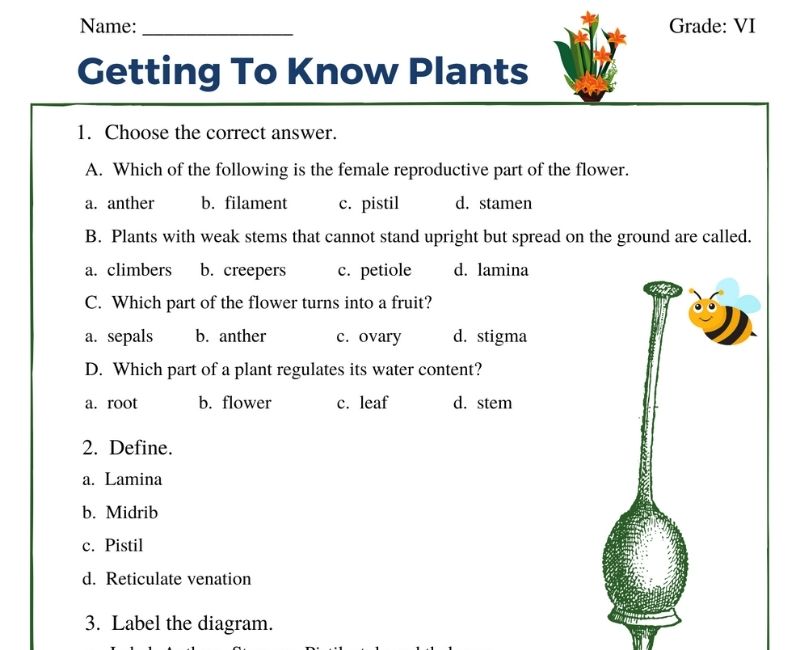
NCERT Solutions Class 6 Science Chapter 7 Getting to Know Plants NCERT Solutions
Answer: (a) a leaf (b) a taproot (c) a flower Question 3: Can you find a plant in your house or in your neighborhood, which has a long but a weak stem? Write its name. In which category would you classify it? Answer: Money Plant has a ling but weak stem. It is a climber. Question 4: What is the function of a stem in a plant?

Class 7 Science Chapter 1 Nutrition in Plants Extra Questions Answers Notes New Science
Answer: Class 6 Science Ch 7 Extra Questions Question 3. Look carefully at the plants shown in Fig. 7.17 and identify their type. Are they herbs, shrubs or trees? Are they similar in shape? Which category has the biggest plants and which has the smallest? Answer: Close look of these plants make it clear that these plants are not of the same type.

Class 6 Science Chapter 9 Question Answer Getting to Know Plants Question Answer Science
Can you find a plant in your house or in your neighbourhood which has a long but a weak stem? Write its name. In which category would you classify it? Ans: Yes, we find a money plant in our house. It is a climber. 4. What is the function of a stem in a plant? Ans: A stem performs following functions:

Getting to know Plants Class 6 Science Chapter 7 Extra Questions.
All plants have colourful flowers. Answer. 9. The parts of a flower are usually present in whorls. Answer. 10. Pistil is female reproductive part of a flower. Answer. We hope the given NCERT MCQ Questions for Class 6 Science Chapter 7 Getting to Know Plants with Answers Pdf free download will help you.

Getting to know plants for class 6 Notes, MCQs and Extra Questions and answers
Answer: Ovary Getting To Know Plants Class 6 Notes Questions And Answers Question 6. Name two types of roots found in plants. Answer: Taproot Fibrous root Getting To Know Plants Extra Questions Question 7. Name the process by which plant make their food. Answer: Photosynthesis Getting To Know Plants Class 6 Question 8.

NCERT Class 6 Science Chapter 7 Getting to Know Plants Extra Questions
Free PDF download of Important Questions with solutions for CBSE Class 6 Science Chapter 7 - Getting to Know Plants prepared by expert Science teachers from latest edition of CBSE (NCERT) books. Register Online for NCERT Class 6 Science tuition on Vedantu.com to score more marks in CBSE board examination.

NCERT Solution Class 6 Science Getting To Know About Plants
NCERT Solutions for Class 6 Science Chapter 7 Getting to Know Plants. Question 1. (a) Stem absorbs water and minerals from the soil. Roots absorb water and minerals from the soil. (b) Leaves hold the plant upright. The stem holds the plant upright. (c) Roots conduct water to the leaves. Stem conducts water to the leaves.

Classification of Plants Chapter7 Getting to know Plants Science Class 6 YouTube
These Class 6 Science Chapter 4 Extra Questions are completely based on NCERT Book for Class 6 Science Chapter 4 - Getting to know Plants. These Extra Questions contains detailed explanation or Definition of some Terms talked about in NCERT Class 6 Science Chapter 4 - Getting to know Plants.

Getting to Know Plants Class 6 Extra Questions and Answers Science Chapter 7 NCERT MCQ
Question 1. Which is a shrub among the following? (a) Spinach (b) Mango tree (c) Lemon (d) Pipal Answer Question 2. Which of the following type of plants has thick, hard and woody stem? (a) Climber (b) Herb (c) Shrub (d) Creepers Answer Question 3. Which part of plant helps to carry food to all parts of plant? (a) Root (b) Stem (c) Leaf (d) Flower

QUIZ / Class6 SCIENCE/ Getting to know plants / NCERT SCIENCE Chapter / Extra MCQ Question
Question 1 GIVE REASONS FOR THE FOLLOWINGS. (i)Why plants like cactus develop spines? (ii)'Transpiration do not take place at night'. (iii)Why leaves are green in colour? (iv)'Tap root is also known as true roots' (v)Mango is known as a tree and not as shrub. Answer Question 2 HOTS (i)Why complete flowers are also known as bisexual flower?

(PART1) Getting To Know Plants / Class6 SCIENCE NCERT Chapter 7 हिन्दी Explanation ByKV
In this video, we will study Chapter-7 Getting to know plants, Class6, Science.Here is a list of topics included in this video:1. Extra Questions-----.

Getting to Know Plants Class 6 Notes Science Chapter 7
Let's understand more about Plants! Plants are necessary for the survival of every living being on the planet and the chapter 7, Getting to know plants, will help you understand why this is true.You will learn about plants with the help of various concepts, NCERT questions and extra questions prepared by the experts at Teachoo.. Plants are categorised into 3 categories on the basis of their.

CBSE Class 6 Science Chapter 7 Getting To Know Plants CBSE Study Group
Solution: a) Roots absorb water and minerals from the soil. b) Stem holds the plant upright. c) Stems conduct water to the leaves. d) The number of petals and stamens in a flower may not always be equal. e) If the sepals of a flower are joined together, its petals are separate.

CLASS 6 SCIENCE CHAPTER 7 GETTING TO KNOW PLANTS QUESTION ANSWERS YouTube
1. List few plants found around your house. Answer: Mango, neem, grass, chilli, palak and banyan tree. 2. Are all the plants same in size? Answer: No, all plants are of different sizes. 3. What are the major parts of plants? Answer: Stem, root, leaves and flowers. 4. How many kinds of plants are there? Answer: There are three kinds of plants:
CBSE Class 6 Science Getting to Know Plants MCQs, Multiple Choice Questions
1. List few plants found around your house. Answer: Mango, neem, grass, chilli, palak and banyan tree. 2. Are all the plants same in size? Answer: No, all plants are of different sizes. 3. What are the major parts of plants? Answer: Stem, root, leaves and flowers. 4. How many kinds of plants are there? Answer: There are three kinds of plants:

Printable Getting to Know Plants Class 6 Worksheet
Question 1. What are herbs? Answer: The small plants with soft/tender, green, short stem are called herbs. Herbs hardly attain height more than 1.5 metres. Their stems are not woody and can be bent. A herb may or may not have branches, e.g., tomato, mint, paddy, etc. Question 2.